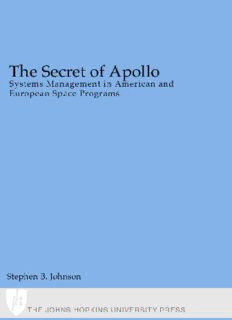
The Secret of Apollo. Systems Management in American and European Space Programs PDF
Preview The Secret of Apollo. Systems Management in American and European Space Programs
The Secret of Apollo New Series in NASA History RogerD.Launius SERIES EDITOR BeforeLift-off:TheMakingofaSpaceShuttleCrew HENRY S. F. COOPER, JR. TheSpaceStationDecision:IncrementalPolitics andTechnologicalChoice HOWARD E. MCCURDY ExploringtheSun:SolarSciencesinceGalileo KARL HUFBAUER InsideNASA:HighTechnologyandOrganizational ChangeintheU.S.SpaceProgram HOWARD E. MCCURDY PoweringApollo:JamesE.WebbofNASA W. HENRY LAMBRIGHT NASAandtheSpaceIndustry JOAN LISA BROMBERG TakingSciencetotheMoon:LunarExperimentsandtheApolloProgram DONALD A. BEATTIE Faster,Better,Cheaper:Low-CostInnovationintheU.S.SpaceProgram HOWARD E. MCCURDY TheSecretofApollo:SystemsManagementinAmericanand EuropeanSpacePrograms STEPHEN B. JOHNSON SpacePolicyintheTwenty-FirstCentury EDITED BY W. HENRY LAMBRIGHT T H E S E C R E T O F A P O L L O Systems Management in American and European Space Programs Stephen B. Johnson TheJohnsHopkinsUniversityPress BaltimoreandLondon ©2002TheJohnsHopkinsUniversityPress Allrightsreserved.Published2002 PrintedintheUnitedStatesofAmericaonacid-freepaper 2 4 6 8 7 5 3 1 TheJohnsHopkinsUniversityPress 2715NorthCharlesStreet Baltimore,Maryland21218-4363 www.press.jhu.edu LibraryofCongressCataloging-in-PublicationData Johnson,StephenB.,1959– ThesecretofApollo:systemsmanagementinAmericanand Europeanspaceprograms/ StephenB.Johnson. p. cm.—(NewseriesinNASAhistory) Includesbibliographicalreferencesandindex. ISBN0-8018-6898-X(hardcover:alk.paper) 1.Astronautics,Military—UnitedStates—Management. 2.Astronautics—UnitedStates—Management. 3.Astronautics, Military—Europe—Management. 4.Astronautics—Europe— Management. I.Title. II.Series. UG1523.J6452002 629.4'0973—dc21 2001005688 AcatalogrecordforthisbookisavailablefromtheBritishLibrary. To Diane Contents ListofIllustrations ix PrefaceandAcknowledgments xi AbbreviationsandAcronyms xv Introduction:ManagementandtheControl of ResearchandDevelopment 1 1 SocialandTechnicalIssuesofSpaceflight 5 2 CreatingConcurrency 19 3 FromConcurrencytoSystemsManagement 47 4 JPL’sJourneyfromMissilestoSpace 81 5 OrganizingtheMannedSpaceProgram 115 6 OrganizingELDOforFailure 154 7 ESRO’sAmericanBridgeacrossthe ManagementGap 179 8 CoordinationandControlof High-Tech ResearchandDevelopment 209 Notes 233 EssayonSources 277 Index 283 Illustrations ‘‘Flybeforeyoubuy’’sequentialdevelopment 22 WeaponSystemProjectOffice’ssystemconcept 31 OrganizationoftheInglewoodcomplex 35 Pre-Gilletteorganizationofballisticmissiledevelopment 38 Ballisticmissileorganization—GilletteProcedures 39 Concurrency 42 BrigadierGeneralBernardSchrieverandDr.SimonRamo 52 AtlasDlaunch 59 BallisticSystemsDivisionorganizationnetwork 69 Systemsmanagementphases 74 Traditionallineorganizationandlinesofcommunication 77 Matrixorganization 78 MarinerVenus1962 99 Rangerspacecraft 101 Typicalprofileofengineeringchangesforspacecraftproject 108 Mercury-Atlasorganization 119 GeorgeMueller’s‘‘fivebox’’structure 135 GeorgeMuellerandSamuelPhillips 136 Phillips’sreviewprocessesforApollo 142 Apollowithitsmajorcontractorsidentified 144 HEOSspacecraft 188 Hoernke’sanalogyofengineeringandprojectcontrol 198 TheESROPlanning,Management,andControlSystem 200 ColdWarsocialgroupsandalliances 213 AuthoritychangesatNASAandESRO 214 Systemsmanagementmethodsclassifiedbysocialgroup 215 Preface and Acknowledgments ThisbookbuildsonhistoricalresearchIcarriedoutoverthelastsevenyears and also on my own history and values. I did not begin with the intention ofstudyingsystemsmanagementorsystemsengineering,subjectsfamiliarto mefrommybackgroundintheaerospaceindustry.Infact,Imadesomeeffort atthestartnottodoso,toavoidmyownbiases.Originally,Iwantedtouse myaerospaceexperiencebutalsotoseparatemyselfsomewhatfromitsoas tolookatthehistoryoftheaerospaceindustryfromamoredetachedstand- point.IeventuallydecidedtoinvestigatemorecloselytheSpacelabprogram, ajointeffortoftheNationalAeronauticsandSpaceAdministration(NASA) andtheEuropeanSpaceAgency(ESA).ThisseemedagoodchoicebecauseI knewsomethingofspacetechnologybutlittleaboutmannedlaboratoriesor ESA. Spacelab looked like a good case of technology transfer from the United StatestoEurope.YetIfoundlittlenoveltyinSpacelab’shardwaretechnology, and neitherdid the Europeans. Sowhy were they interested in this project? Theywantedtolearnhowtomanagethedevelopmentoflarge,complexspace systems—thatis,themethodsof‘‘systemsmanagement.’’SoonIencountered the ‘‘technology gap’’ and ‘‘management gap’’ literature, the pervasive rhe- toric about ‘‘systems,’’ and the belief in the Apollo program as a model for how to solve social as well as technical problems. This was a worthy topic, particularlybecausenootherhistorianhadinvestigatedit. Systemsapproachesemphasizeintegrativefeaturesandtheelementsofhu- man cooperation necessary to organize complex activities and technologies. Believingthathumansareirrational,Ifindthecreationofhuge,orderly,ratio- naltechnologiesalmostmiraculous.Ihadneverponderedthedeeperimpli- xii PrefaceandAcknowledgments cationsofcooperativeeffortsamidirrationalityandconflict,andthisproject hasenabledmetodoso. I owe a debt of thanks to many. At the History Office at NASA headquar- ters, Roger Launius, Lee Saegesser, and Colin Fries were helpful in guiding methroughthecollections.JulieReiz,ElizabethMoorthy,andMichaelHooks providedexcellentserviceattheJetPropulsionLaboratoryarchives,declassi- fying numerous documents for my ratherdiffuse research. At the European CommunityarchivesattheEuropeanUniversityInstitute(EUI)inFlorence, Italy,GherardoBoninilocatednumerousdocumentsandprovidedmanyrec- ords I would not have otherwise noticed, sending some to me later when I foundthatIneededmoreinformation.TheTechnicalInformationandDocu- mentation Centerat the ESA’s European SpaceTechnology Centre (ESTEC) opened its doors (literally) for me, allowing me to rummage through store- rooms full of documents, as well as its collection of historical materials. ESTEC’sLilianViviani,LhorensMarie,SarahHumphrey,anddirectorJean- JacquesRegnierwereallextremelyhelpful.JohnKrige,whoheadedtheEuro- pean Space History project, provided travel funding to visit the EUI and ESTEC archives. I am particularly grateful for his help and trust in me, be- causehejump-startedmyresearchwhenitwasinitsveryearlystages. In 1998 and 1999 I performed related research for the Air Force History SupportOffice,contractnumberF4964298P0148.Thisprovidedtravelfunds and support for my graduate student Phil Smith. I am grateful to Phil for doingmuchofthe‘‘legwork’’todiguparchivalmaterialsintheBostonarea and at Maxwell Air Force Base in Montgomery, Alabama. Chuck Wood in theSpaceStudiesDepartmentoftheUniversityofNorthDakotaencouraged meinthiswork,andIappreciatehisunderstandingandsupportforthisre- search among myother facultyduties. I thank Cargill Hall, Rich Davis, and Priscilla Jones for their efforts on my behalf in the History Support Office. HarryWaldronattheSpaceandMissileCenterwasextremelyhelpfulingath- eringfurthermaterialsonballisticmissiles. Also providing funding for my research was the Universityof Minnesota ResearchandTeachingGrantandDissertationFellowshipprogram.Thepro- fessorsattheUniversityofMinnesotawithwhomIstudiedfrom1992to1997 taughtmemuchofwhatitmeanstobeahistorian.DavidGoodandGeorge
Description: